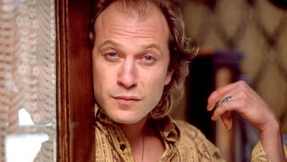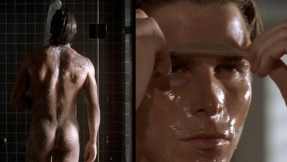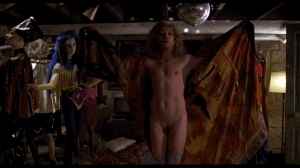The Serial Killer’s Struggle With Physical and Sexual Identity
Serial killers have become a sensation. No longer are these predatory killers merely figures that haunt our nightmares or the faces that flash on the news at night. Instead, they are sensationalized images of horror, a force to be conquered by the heroic male. They are seen as mental illness embodied to the most violent extreme, but these fictional portrayals are not to be seen as models for mental illness. Instead, they should be seen as characters who are struggling with some kind of identity, an identity that is not just conveyed by their actions but also through their physical body. The characters that will specifically focused on are Buffalo Bill from Jonathan Demme’s 1991 film Silence of the Lambs and Patrick Bateman of Mary Harron’s 2000 film American Psycho, two fictional serial killers who both kill to gain some identity they do not believe they possess: a female identity in the case of Buffalo Bill and an upper-class, ordinary male identity for Bateman.
These two characters represent both the extreme violence of both men but also the extreme opposite of their representations on screen. Buffalo Bill is a secondary villain and a hunted character, seen as evil in both his killing and his desire to transform into a woman, while Patrick Bateman is the film’s narrator and completely unsuspecting to those around him, which creates some kind of sympathy for his desire to merely fit into the decadent upper classes of New York City; Buffalo Bill is the villainized and feminized homosexual, while Bateman is the beautiful supposed pinnacle of masculinity. While their depictions are different, both characters convey a societal fear or worry: sexual and gender identity in the case of Bill and the destructive nature of capitalism in Bateman. Both men are struggling with identity grounded in their physical body, all-the-while seemingly coping with mental illness, with this illness being exaggerated in their physicality and their need to kill. Through these differences in depictions, the representations of Buffalo Bill and Patrick Bateman’s desires to change their bodies, and the representations of their bodies on screen, convey ideas about cultural ideology while influencing how we read the body of the serial killer.


In Silence of the Lambs, Jame “Buffalo Bill” Gumb specifically wishes to become a woman, an identity he desires and believes should be his own. To aid this transformation, and to cope with this desire to become a woman in the only way he believes is possible, he begins to kill and skin women to create a women suit, an act that is villainized from the film’s very beginning as the FBI is trying to hunt him down. As stated by Robert Cettl, “Bill is concerned with transformation and transcendence, and kills to maintain that process. He believes he is in a process of becoming” (Cettl, 413). But it is not just his murderous desires that villainizes him; it is also his transgender identity.
From the film’s beginning, BIll is represented as a severely mentally disturbed man that not only kills woman, but wishes to become one, which makes him even more terrifying. He is mentally ill not just due to the murders he commits, but also due to his sexual and gender identity and this desperate desire for transformation was seen by some as a “character of the serial murderer [that] had attributes associated with stereotypes of gay men” (Staiger, “Taboos and Totems”). Buffalo Bill’s sexual identity is portrayed as evil and is exaggerated with his need to kill to reaffirm this sexual identity. What is most surprising is not many critics discuss or even mention Buffalo Bill being transgender; they only discussed his identity as a gay man. In the film, his sexual desires are barely addressed, while his desire to become a woman is primarily focused upon. Perhaps these critics did not have the language to discuss transgender issues and perhaps Demme was not aware of issues of transphobia. However, he was aware of issues of homophobia and we are aware of issues of transphobia now; this film does reflect the fear of a man wanting to let go of his superior, stronger male identity for a weaker, submissive female identity.
This fear is most depicted through Bill’s physical body. He is created as the stereotypical vision of the serial killer as he lives in the dark, isolated space of his basement and rarely enters public spacse unless he absolutely needs to, which in the context of the film means to kill. He sits alone in his basement with his little dog and dresses in drag, which brings the film to one of what is supposed to be one of its most grotesque scene, yet audiences view it as comedic. In this scene, Bill is applying make-up and whispers to his reflection, “Would you fuck me? I’d fuck me.” Then, in front of a camera, Bill tucks his penis between his legs and reveals his body as feminine as he can make it; he is temporarily removing the biological evidence of his masculinity to become his true self. This scene is the subject of parody and laughter on shows such as Family Guy and Robot Chicken as well as countless parody videos on YouTube; but why? It is because Bill’s body is going against what we are meant to expect, as we are conditioned to believe that the masculine body is the most desired body, something that should be wished for, not detested; it is terrifying that a man would ever want to become a woman and we deal with this fear through comedy. Even more, Demme’s presentation of his “transformed” body is in such a way that seems comedic and grotesque, presenting Bill as a terrifying caricature that needs to be stopped and ultimately destroyed by the FBI. This is not just a commentary on fear of the homosexual, but fear of the transsexual as well.

Due to the fact that Buffalo Bill does not receive much screen time, it is helpful to compare him to certain characters in the film. First, Buffalo Bill is contrasted against another serial killer, Hannibal Lecter, not just through Bill’s sexual deviance and Hannibal’s removal from such motivation, but also through economic class and level of education, which creates a strange hierarchy of serial murderers. This hierarchy makes Bill seem much more evil than Lecter, even though both are serial murderers and Lecter even eats his victims; in description, there should be little to no difference between perception of these two men. Yet, the representation of Buffalo Bill as a sexual deviant in contrast to Lecter only makes him more terrifying while Lecter is given a more “heroic” status in the film. The term “heroic” is being used very loosely used in this context, but he aids the FBI in their profiling and hunt of Bill, helping catch the killer instead of doing the killing himself. Buffalo Bill is seen as “an immature sexual deviate” who “is closer to an animal” as he “is prone to savagery” (Cettl, 415) while Lecter is the calm, civilized, “cultured centerpiece of a bizarre freak show” (Cettl, 414) in his psychiatric cell.
Both are also in their own respective cages: Lecter in his literal prison cell and Buffalo Bill both in his basement and his sexual identity; yet, Lecter’s cage is light, orderly, and clean while Bill’s is dark and chaotic. Staiger provides an accurate summary of the binary between Lecter and Bill, saying that Lecter is rich, wise, clever, helpful, funny, straight, and abstract evil while Gumb is working-class, stupid, dense, dull, gay, and evil incarnate. Despite both of their crimes, Buffalo Bill is still seen as the worse of the two because of his class, gender, and education, having no redeeming qualities while Lecter is the “lovable” killer. Even more, Bill’s evil is ultimately overcome at the film’s end while Lecter escapes, which audiences almost want to cheer for rather than fear.
Then, Bill is contrasted against the female FBI agent Clarice Starling, another marginalized feminine character amongst a sea of the masculine. Demme creates an “interaction of opposed pairs, or ‘doubles’” (Phillips, “The Silence of the Lambs”) where both of these characters are portrayed, at least at times, as similar in their marginalized gender representations and their desire to attain an aspect of identity they do not already have: Clarice as a respected female agent in the FBI and Bill as a women. However, despite their similarities, Clarice is the heroic feminine while Bill is the villain feminine. As stated by Julie Salamon, Clarice “is a rare heroine, a woman who goes about her work the way men do in movies, without seeming less a woman” (Salamon, “Weirdo Killer Shrink Meets the G-Girl”). She is doing a man’s job while retaining aspects of femininity, striking a balance that Buffalo Bill cannot obtain.

Still, she and Bill are marginalized in their gender representation, which puts them on a similar level. However, Clarice’s feminine attributes are praised as they are only beneficial to the investigation while Bill’s feminine attributes, as previously stated, are seen as evil and grotesque; femininity seems to be praised in the film when used properly by a woman. Due to their similarities, it seems only natural that Clarice and Bill would have a final showdown of sorts where these two marginalized characters confront one another. In this confrontation, Clarice, the heroic feminine, ultimately conquers Buffalo Bill and therefore eliminates this grotesque evil as a seeming triumph over this societal fear of sexual deviancy; to Staiger, Buffalo Bill’s “death as an ‘unnatural’ person [is] met with a sigh of relief” (Staiger, Taboos and Totems).
In comparison to feminized, villainized, and ultimately defeated Buffalo Bill, there is Patrick Bateman of Mary Harron’s American Psycho, adapted from Bret Easton Ellis’ novel of the same title. Unlike Bill’s position as a secondary character, Bateman is the film’s narrator and focus as we follow his day-to-day attempts to fit into everyday, early 90s upper class life. But, these attempts are thwarted at night, when he gives into violent impulses, thought of as mental illness, to sexually assault, torture, and murder anything he can find. Bateman is the embodiment of capitalist decadence that has a cool exterior but violent interior that wants nothing more than to literally tear everyone apart. However because he is our narrator, there is more of a tendency for sympathy for Bateman as we receive more understanding of his motivations and reasoning than with Bill; we are offered more insight into “the madness.” However, these murderous impulses are what happens when he tries to reign in his “madness” and merely fit in. He knows he is mentally ill, particularly when he is shown taking prescription antipsychotic. However, it is not the mental illness that has driven him to kill but his obsessive need to fit in; he kills to protect his social position.
As opposed to the villianized feminization of Buffalo Bill, Bateman attempts to fit in through extreme masculinization and careful attendance to appearance as he wants nothing more than to appear like “one of the guys” and “exemplifies the crisis of masculinity by serving as an imagined male normative identity” (Moore, 238). While Bill is represented as a lower class, unintelligent hermit, the type of character we would associate with the image of a serial killer, Bateman is the opposite: he is wealthy, high class, well-educated, well-dressed, and social. In this way, Bateman is similar to the previously mentioned Hannibal Lecter: both are wealthy, intelligent, masculine, heterosexual, and could be considered “abstract evil” in the words of Steiger. Lecter’s evil is obvious and yet he wishes to help Starling despite his crimes while Bateman’s evil is caused by rampant capitalism. Can he be blamed for his murderous tendencies or do we instead blame capitalism’s effect on younger generations? Bateman’s evil may be much more abstract than even Lecter, and yet the important point is to realize their similarities particularly in comparison to Buffalo Bill.
Bateman is the film’s narrator and the only perspective we receive throughout the entire film. This technique is particularly unsettling because we find ourselves identifying with the killer. In Casey C. Moore’s article, “We’re Not Through Yet,” Moore states:
“The reader/viewer’s alignment of him or herself with Bateman is particularly discomforting because s/he expects Bateman’s representation to include the standard elements of the Symbolic serial killer—including psychological reasons for killing, accentuated difference that separate him from the reader/viewer, and atonement for the crimes of the killer—but they do not appear… There is a discrepancy between the assumed definition of ‘serial killer’ and Bateman’s character.” (Moore, 235)
What is unsettling about Bateman is that there is no distance between the audiences and himself like there is with Buffalo Bill in Silence of the Lambs. Even more, Martin Rogers believes Bateman is presented as “the everyman of his culture” and “this desirability [for his perfected body] makes it difficult to reconcile Patrick’s ‘every-body’ as that of the typical monster or as its dialectical progeny the ‘slasher’ or serial killer” (Rogers, 234). This keeps audiences from seeing him as true killer or monster despite his actions. Audiences instead see what outside factors cause such numbness and violence. However, this is the opposite for Buffalo Bill as we never receive his perspective, only how he is perceived by others. He is made to be grotesque, stupid, and the stereotypical vision of one that kills, not the everyman Bateman is portrayed to be.
To achieve this perfect mask of the everyman, Bateman must follow a precise and specific routine, which is seen within the first five minutes of the film. This sequence is narrated by Bateman himself in a detached monotone as he speaks about eating a balanced diet and keeping his face from becoming puffy, all while he does his morning exercise routine. Throughout this entire monologue, the camera is focused upon his practically naked, perfectly toned, perfectly tanned body “as a lavish display of eroticized masculinity” (Rogers, 234). Then, we move into the shower where Bateman is completely naked and begins narrating precisely what products he uses in the shower and out. His regimen is strict and well thought out as each product plays a specific role in maintaining his appearance, from skin to hair. Moore describes this scene as one of an “aesthetic of boredom” but I disagree; I believe it establishes the routine Bateman must follow to maintain his mask of perfection and normalcy. Without each cream, gel, or lotion, cracks would appear in this smooth, perfect exterior.

The most important moment occurs when Bateman peels off his facial mask, which resembles a layer of skin. It is the first moment where Bateman is talking not about his routine but about his inner self:
“There is an idea of a Patrick Bateman, some kind of inner abstract. But there is no real me, only an entity, something illusory. And though I can hide my cold gaze, and you can shake my hand… I simply am not there” (Harron, American Psycho).
The entire documented routine is just a mask: Bateman has no concrete identity, only what his body presents to the world. But that’s it: it is only a body. Bateman does not claim any true attachment to this body, only what it can provide him in terms of success. This opening sequence is telling of Bateman as a whole and emphasizes that his careful attentiveness to physical appearance is his mask and any cracks in the perfection will expose the killer underneath.
If Buffalo Bill represents a threat of homosexual identity, then Bateman represents the threat of the 1990s upper-class decadent lifestyle and, by extension, capitalism. All Bateman wants to do is be a V. P. of an investment banking firm, wear expensive suits, snort cocaine, and have copious amounts of sex, but only because he believes that is what he is supposed to do with his life. He and all of his friends have the same eggshell glasses, the same cut suits, even the same haircuts. Bateman is even constantly mistaken for a coworker due to the uniformity of their looks. Any threats to this lifestyle are violently eliminated, particularly Paul Allen. Allen’s threat is represented by his business card and his ability to acquire reservations at the exclusive restaurant, Dorsia. Paul Allen’s business card, a thing of beauty, is described as having “subtle off-white coloring, that tasteful thickness of it… it even has a watermark” (Harron, American Psycho). Such mundane, material things bring Bateman to murder so he can keep his place in society.
This fear of capitalism represented through Bateman continues through the economic status of his victims. Besides the murders of those who seem to stand in his way, Bateman murders countless women, particularly prostitutes, in increasingly brutal ways as his own sanity begins to unravel. While he is involved in two sexual, non-violent relationships, he sexually assaults and kills countless nameless women to satiate his violent and murderous desires. While he struggles during the day to fit into this upper class identity, at night he becomes a “monster.” However, it is interesting to note that a majority of the women we witness Bateman killing are working class or extremely vapid: essentially, Bateman preys on the weak, the poor, and the stupid, using his power as a rich white male to lure in his victims only to torture, mutilate, and kill them. As the film enters its conclusion, we see, from a prostitute’s point of view, the labyrinth of murder Bateman has created in a penthouse apartment with dead bodies and blood covering every room. However, we later find that this apartment is totally clean and unoccupied, never touched by Bateman.
This leads to many questions about Bateman, particularly if he actually ever killed anyone or if this was all in his mind; was this merely a troubled man’s fantasy? This establishes the idea that “Bateman is not a ‘single, unified, coherent identity” (Storey, 58). His monstrous desire to kill, outside of those who threaten his societal position, is how Bateman copes with the world around and how he tries to resolve his identity crisis. However, he uses women’s bodies as objects to project his aggression upon, which combined with the murder of those who have a better business card than his own, lend to the message of the destructive nature of upper class white men; capitalistic ideological desires emphasize material goods over human life and have created the sociopathic killer that is Patrick Bateman. He is both disgustingly violent murderer and victim of a dominant capitalistic society.
Serial killers have become a huge part of popular culture, becoming a “’serial killer industry” as described by Henrike Lehnhuth. It comes down to a fascination regarding identity, sex, and violence; but even more we want to be detached from the killer and see him defeated. The contrast between The Silence of The Lamb’s Buffalo Bill and American Psycho’s Patrick Bateman illustrate this fascination. Bill is a sexual deviant and the standard image of a monstrous killer and is ultimately conquered while Bateman is our narrator, an everyman, a perfect body, and his actions are never punished; Bill is the fear of homosexuality and Bateman is the fear of capitalism and materialism. Both are monstrous, both are serial killers, and yet each receives different treatment in regards not only to narration but the portrayal and treatment of their bodies. Bill is the stereotypical representation of the treatment of the “Other” that threatens the status quo and needs to be eliminated, while Bateman is the typical upper-class heterosexual white male. Their bodily portrayal also convey desires for change, with Bill’s metamorphosis into a woman’s body and Bateman’s constant care of his mask to “fit in.” There is so much more to the representations of these male serial killers besides their implied mental illness. It is not just about the violence they are capable of but all also about how the representation of their bodies and identities on screen influence our reading of their character as both a villain and a victim.
Works Cited
Cettl, Robert. Serial Killer Cinema: An Analytical Filmography With An Introduction. Jefferson, N.C.: McFarland & Co., 2003.
Lehnguth, Henrike. “The Killer Inside: First-Person Narration and the Reader/Viewer in Serial Killer Narratives.” American Lives. Heidelberg: Universitatsverlag, 2013.
Moore, Casey C. “We’re Not Through Yet: The Patrick Bateman Debate.” Comparatist: Journal Of The Southern Comparative Literature Association 36 (2012): 226-247.
Phillips, Kendall R. “The Silence of the Lambs (1991).” Projected Fears: Horror Films and American Culture. Westport, C.T.: Praeger Publishers (2005): 181-194.
Rogers, Martin. “Video Nasties and The Monstrous Bodies of ‘American Psycho.’” Literature Film Quarterly 39.3 (2011): 231-244.
Salamon, Julie, “Film: Weirdo Killer Shrink Meets the G-Girl.” Wall Street Journal, 14 February 1991.
Staiger, Janet. “Taboos and Totems: Cultural Meanings of The Silence of the Lambs.” Perverse Spectators: Practices of Film Reception. New York: New York University Press (2000): 161-178.
Storey, Mark. “’And As Things Fell Apart:’ The Crisis of Postmodern Masculinity in Bret Easton Ellis’s American Psycho and Dennis Cooper’s Frisk.” Critique: Studies in Contemporary Fiction 47.1 (2005): 57-72.
What do you think? Leave a comment.











Christian Bale chews the scenery like a demon. Must watch if you’re into that sorta thing.
A masterpiece of controlled writing with not a word wasted, American Psycho continues to shock and disgust me each time I read it (three times now and counting), but what amazes me most each time I revisit it is the humour and pathos, the pained humanity of its monstrous narrator screaming out from the void of Ellis’ prose. The film version was a toothless pussycat by comparison, but full marks to Bale for his peerless Bateman (whose slow, almost dreamlike diction was surely modelled on Ellis himself?)
To me, American Psycho will always be one of the most graphic yet unput-downable reads, ever! In 30 years of reading I’d rate it with Bram Stoker’s Dracula for edge, and Dracula is acknowledged to be a classic. I’ll never forgot reading the chapter with the tramp’s murder, when I was on the train to work, and being totally ‘creeped out’ yet compelled to read it again. I also thought that the film was a great adaptation with Christian Bale capturing the edgy, posturing yet insecure Bateman. Yet, I laughed inside so many times over the lists, clothing obsessions and the ridiculous menus at the restaurants. In fact, I must get my copy out and have another read, after I’ve read Imperial Bedrooms, that is …..
Great analyses. Too bad Ted Levine didn’t win an oscar for this performance in Silence of the Lambs.
I really enjoyed the section about Bateman wearing a “mask” and having no concrete identity. Makes you think if any of us are much more than what our body projects to other people. Interesting analysis about serial killers and identity.
Great analysis! I really enjoyed reading about how Buffalo Bill and Clarice are viewed as doubles. I agree on your discussion depicting fear through Buffalo Bill’s body. I never thought of that scene being the fear of the transsexual and I’m really glad you focused on that. Great job.
I found that American Psycho was a highly odd and disturbing. I couldn’t even finish watching it to the end. What surprised me was Christian Bale ability to take on that role.
Interesting topic on two of my favorite movies. I am particularly interested in the way you define Buffalo Bill as “effeminate, stupid, and terrifying.” Effeminate, obviously. Terrifying, absolutely. But I think it is most interesting that you point out that he is in fact stupid. This is quite contrary to the stereotypical villain. We usually see movies try to portray villains as these evil geniuses, especially when it comes to suspenseful and terrorizing movies like Silence of the Lambs. It is extremely intriguing to me how Buffalo Bill can still retain a terrifying nature and produce the terrorized effect in the audience while being…well…pretty simple minded.
I love your point about the audience wanting to cheer for Lecter. It brings to mind the end of the film, where really we should be horrified that he’s about to eat someone, bust instead we’re thankful that he escaped and that he’s getting revenge on a character we didn’t really like (despite that character not doing anything ‘evil’ in the entire film). This is all despite the fact that we’ve just watched an entire movie dedicated to hoping that the protagonist can stop a serial killer before he kills again.
Yep, I love Patrick Bateman. A whole big lot.
An interesting look at the identity of a serial killer and mental illness, in general. It is fascinating to note that the extreme psychosis that pushes these characters to kill can be moralized into a desire to be something that they are not. It seems quite natural, and I think that’s where viewers find empathy (and, certainly, fear) for these characters. I said “mental illness, in general” earlier because mental illness can exist in all classes – from Buffalo Bill to Patrick Bateman.
I think that the guy who played as buffalo bill was a perfect choice
Two excellent choices in films to elaborate on this goal. It fascinates me how horror punishes any form of “sexual transgression”.
Fascinating piece.
Thank you for this comparative study. I also can see a place for class structure. In one line from Hannibal another psychologically challenged person from the Silence of the Lambs states to Clarice that you are one step above white trash while the American Psycho is comes from a more elite social and political classification. There could be some factors here worth exploring.
I could not finish American Psycho it was too close to the surface. It is just slightly submerging under a thin layer of ice ready to be present in many conditions . The Silence of the Lambs is one of my most favorite haunting film.
Although I thought your writing is good I feel as if a lot of the article is opinion based and I disagree with some of your statements with the Buffalo Bill being “gay” or “men being the most desired of all and women considered to be weak”. Even if that’s not what you meant it came across, to me at least, very opinionated and not exactly factual towards what the movie is about and you could cut out words. Not everything needs to detailed in such a manner that we miss the point of the article. Overall I thought you’re topic was interesting, but I feel you could improve on style. Keep writing!
Enjoyed reading this! Your points about perspective were good- about our inability to say whether Bateman’s bloodbath was fantasy or reality . . . Of course, I feel like this is the whole point- that society has become so numb to/so bored with violence that this distinction ultimately doesn’t matter, which is a deftly subversive way of holding up a mirror to the collective psychosis. I feel like Ellis sucks us into a world where transgression no longer exists, where the usual justifications for feeling horror simply dissipate. I think it would be really interesting to compare the movie/book to the Marquis de Sade, libertine philosophy, 120 Days of Sodom (the four main characters range from highly masculine to effeminate, which would make for an interesting extension of your physical/sexual identity analysis.) And since you focus a lot (and very aptly!) on the body as the nihilistic origins of Bateman’s psychosis, there is also a book I would recommend: “Sade: the Invention of the Libertine Body.”